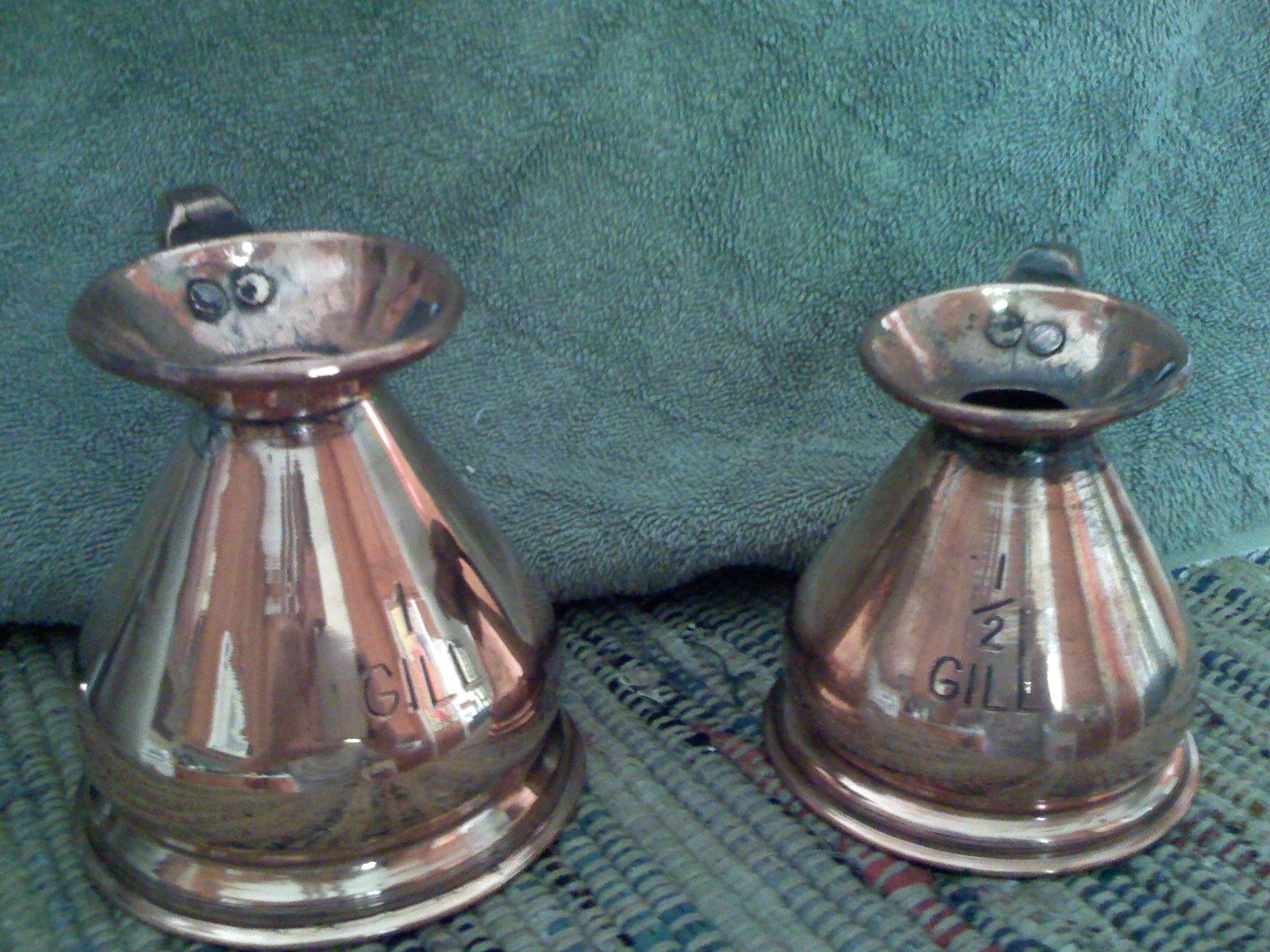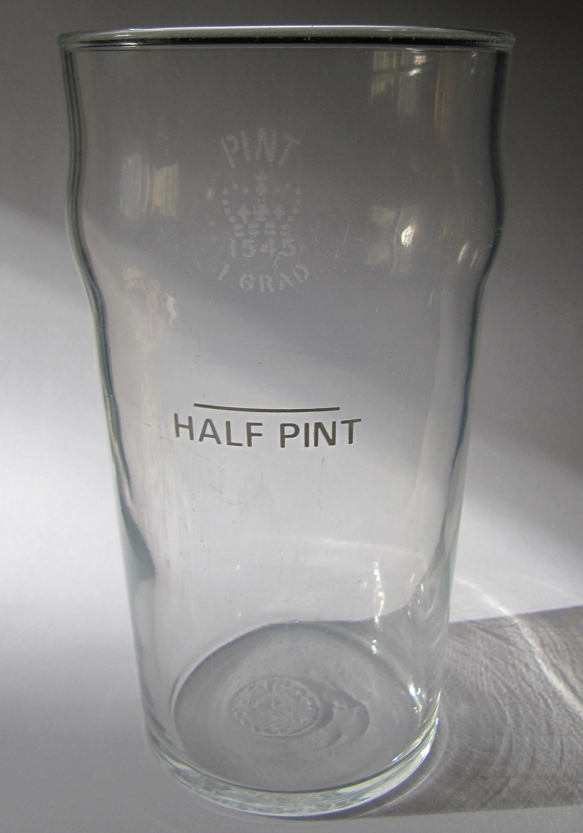|
Pint
The pint (, ; symbol pt, sometimes abbreviated as ''p'') is a unit of volume or capacity in both the imperial and United States customary measurement systems. In both of those systems, it is one-eighth of a gallon. The British imperial pint is 20.095% larger than the US pint because the two systems are defined differently. Almost all other countries have standardized on the metric system, so although some of them still also have traditional units called pints (such as for beverages), the volume varies by regional custom. The imperial pint (≈) is used in Ireland, the United Kingdom, and other Commonwealth countries. In the United States, two kinds of pint are used: a liquid pint (≈) and a less common dry pint (≈). Other former British colonies, such as Australia, South Africa and New Zealand, converted to the metric system in the 1960s and 1970s, so while the term may still be in common use in these countries, it may no longer refer to the British imperial pint once ... [...More Info...] [...Related Items...] OR: [Wikipedia] [Google] [Baidu] |
Pint Glass
A pint glass is a form of drinkware made to hold either a United Kingdom, British imperial pint of or an United States, American pint of . Other definitions also exist, see below. These glasses are typically used to beer glass, serve beer, and also often for cider. Current shapes The common shapes of pint Glass (drinkware), glass are: * Conical (or sleevers) glasses are shaped, as the name suggests, as an inverted truncated cone (geometry), cone around tall and tapering by about in diameter over its height. Also called a "shaker pint" in the United States, as the glass can be used as one half of a Boston shaker. The most common size found in the US holds to the rim. * The (or , pronounced "no-nick") is a variation on the conical design, where the glass bulges out a couple of inches from the top; this is partly for improved grip, partly to prevent the glasses from sticking together when stacked, and partly to give strength and stop the rim from becoming chipped or "nicked". T ... [...More Info...] [...Related Items...] OR: [Wikipedia] [Google] [Baidu] |
Imperial Unit
The imperial system of units, imperial system or imperial units (also known as British Imperial or Exchequer Standards of 1826) is the system of units first defined in the British Weights and Measures Act 1824 and continued to be developed through a series of Weights and Measures Acts and amendments. The imperial system developed from earlier English units as did the Comparison of the imperial and US customary measurement systems, related but differing system of United States customary units, customary units of the United States. The imperial units replaced the Winchester measure, Winchester Standards, which were in effect from 1588 to 1825. The system came into official use across the British Empire in 1826. By the late 20th century, most nations of the former empire had metrication, officially adopted the metric system as their main system of measurement, but imperial units are still used alongside metric units in the United Kingdom and in some other parts of the former empi ... [...More Info...] [...Related Items...] OR: [Wikipedia] [Google] [Baidu] |
Quart
The quart (symbol: qt) is a unit of volume equal to a quarter of a gallon. Three kinds of quarts are currently used: the liquid quart and dry quart of the US customary system and the of the British imperial system. All are roughly equal to one liter. It is divided into two pints or (in the US) four cups. Historically, the size of a quart has varied with the different values of gallons over time, and in the case of the dry quart, in reference to different commodities. Name The term comes from the Latin Latin ( or ) is a classical language belonging to the Italic languages, Italic branch of the Indo-European languages. Latin was originally spoken by the Latins (Italic tribe), Latins in Latium (now known as Lazio), the lower Tiber area aroun ... (meaning one-quarter) via the French . However, although the French word has the same root, it frequently means something entirely different. In Canadian French in particular, the quart is called , while the pint ... [...More Info...] [...Related Items...] OR: [Wikipedia] [Google] [Baidu] |
United States Customary Units
United States customary units form a system of measurement units commonly used in the United States and most U.S. territories since being standardized and adopted in 1832. The United States customary system developed from English units that were in use in the British Empire before the U.S. became an independent country. The United Kingdom's system of measures evolved by 1824 to create the imperial system (with imperial units), which was officially adopted in 1826, changing the definitions of some of its units. Consequently, while many U.S. units are essentially similar to their imperial counterparts, there are noticeable differences between the systems. The majority of U.S. customary units were redefined in terms of the meter and kilogram with the Mendenhall Order of 1893 and, in practice, for many years before. T.C. Mendenhall, Superintendent of Standard Weights and MeasuresOrder of April 5, 1893, published as Appendix 6 to the Report for 1893 of the United States C ... [...More Info...] [...Related Items...] OR: [Wikipedia] [Google] [Baidu] |
Gill (unit)
__NOTOC__ The gill or teacup is a unit of measurement for volume equal to a quarter of a pint. It is no longer in common use, except in regard to the volume of alcoholic spirits measures. Imperial ;In imperial units: : US ;In United States customary units: : United Kingdom Prior to metrication in the United Kingdom, the standard single measure of spirits in a pub was in England and Wales, either or in Scotland, and in Northern Ireland. After metrication, this was replaced by measures of either , at the discretion of the proprietor. Half of a gill is a jack, or one-eighth of a pint. But in northern England, a quarter pint could also be called a jack or a noggin, rather than a gill, and in some areas a half-pint could be called a gill, particularly for beer and milk. In Scotland, there were additional sizes: * big gill = * wee gill = * wee half gill = * nip = Ireland In the republic of Ireland, the standard spirit measure was historically gill. It stil ... [...More Info...] [...Related Items...] OR: [Wikipedia] [Google] [Baidu] |
Gallon
The gallon is a unit of volume in British imperial units and United States customary units. The imperial gallon (imp gal) is defined as , and is or was used in the United Kingdom and its former colonies, including Ireland, Canada, Australia, New Zealand, India, South Africa, Malaysia and some Caribbean countries, while the US gallon (US gal) is defined as , and is used in the United States and some Latin American and Caribbean countries. There are four gills in a pint, two pints in a quart, and four quarts (''quarter'' gallons) in a gallon, with the imperial gill being divided into five imperial fluid ounces and the US gill being divided into four US fluid ounces: this, and a slight difference in the sizes of the imperial fluid ounce and the US fluid ounce, give different sizes for the imperial gallon and US gallon. The IEEE standard symbol for both the imperial and US gallons is gal, not to be confused with the gal (symbol: Gal), a CGS unit of acceleration. Definitions ... [...More Info...] [...Related Items...] OR: [Wikipedia] [Google] [Baidu] |
Comparison Of The Imperial And US Customary Measurement Systems
Both the British imperial measurement system and United States customary systems of measurement derive from earlier English unit systems used prior to 1824 that were the result of a combination of the local Anglo-Saxon units inherited from Germanic tribes and Roman units. Having this shared heritage, the two systems are quite similar, but there are differences. The US customary system is based on English systems of the 18th century, while the imperial system was defined in 1824, almost a half-century after American independence. Volume Volume may be measured either in terms of units of cubic length or with specific volume units. The units of cubic length (the cubic inch, cubic foot, cubic mile, etc.) are the same in the imperial and US customary systems, but they differ in their specific units of volume (the bushel, gallon, fluid ounce, etc.). The US customary system has a set of units for fluids, but a different measure for dry goods for the pint, quart and barrel ... [...More Info...] [...Related Items...] OR: [Wikipedia] [Google] [Baidu] |
Fill Line
A fill line is a marking on drinkware indicating the volume of liquid held by the glass. Many countries mandate fill lines on glasses used commercially as a consumer protection measure. European Union and Switzerland Each of the European Union member states had a variety of weights and measures acts regarding legal metrology for all measuring devices used in commerce, including drinkware. As part of the EU's 2004 Measuring Instruments Directive (2004/22/EC), these were harmonised. The transitional period ended on 30 October 2016, meaning all drinkware produced or sold in the EU or Switzerland after this date must conform to the EU directive. Austria In Austria, fill lines are governed by the ''Beverage Container Regulation'' (), which provides error tolerances; glasses between 10 and 50 ml must be within 5% of the declared volume; larger containers must be accurate within 3%. Germany Germany has had a number of weights and measures acts specifically addressing ... [...More Info...] [...Related Items...] OR: [Wikipedia] [Google] [Baidu] |
Cup (unit)
The 'cup'' is a cooking weights and measures, cooking measure of volume, commonly associated with cooking and serving sizes. In the US customary system, it is equal to . Because actual drinking cups may differ greatly from the size of this unit, standard measuring cups may be used, with a metric cup commonly being rounded up to 240 millilitres (''legal cup''), but 250 ml is also used depending on the measuring scale. United States Customary cup In the United States, the customary cup is half of a Pint#US liquid pint, US liquid pint. Legal cup The cup currently used in the United States for nutrition labelling is defined in United States law as 240 :millilitre, ml. Conversion table to US legal cup The following information is describing that how to measure US legal cup in different ways. Coffee cup A "cup" of coffee in the US is usually 4 fluid ounces (118 ml), brewed using 5 fluid ounces (148 ml) of water. Coffee carafes used with drip coffee makers, e.g. Black an ... [...More Info...] [...Related Items...] OR: [Wikipedia] [Google] [Baidu] |
Fluid Ounce
A fluid ounce (abbreviated fl oz, fl. oz. or oz. fl., old forms ℥, fl ℥, f℥, ƒ ℥) is a unit of volume (also called ''capacity'') typically used for measuring liquids. The British Imperial, the United States customary, and the United States food labeling fluid ounce are the three that are still in common use, although various definitions have been used throughout history. An imperial fluid ounce is of an imperial pint, of an imperial gallon, or exactly 28.4130625 mL. A US customary fluid ounce is of a US liquid pint, of a US gallon, or exactly 29.5735295625 mL, making it about 4.084% larger than the imperial fluid ounce. A US food labeling fluid ounce is exactly 30 mL. Comparison to the ounce The ''fluid'' ounce is distinct from the (international avoirdupois) ounce as a unit of weight or mass, although it is sometimes referred to simply as an "ounce" where context makes the meaning clear (e.g., "ounces in a bottle"). A volume of pure water me ... [...More Info...] [...Related Items...] OR: [Wikipedia] [Google] [Baidu] |
Pinto
Pinto is a Portuguese, Spanish, Jewish (Sephardic), and Italian surname. It is a high-frequency surname in all Portuguese-speaking countries and is also widely present in Spanish-speaking countries, Italy, India (especially in Mangalore, Karnataka), France and Israel. Historically, it has been common among political elites in Portuguese- and Spanish-speaking countries, as numerous presidents, prime ministers, and heads of state have shared the surname. In many languages, Pinto means "coloured" or "painted" as it derives from the Late Latin and Classical Latin , and in some cases, at least from the same word in the sense "lively or restless person". It is linguistically related to the name of Columbus' ship '' La Pinta'', meaning "The Painted One", "The Look", or "The Spotted One". Also related, though greatly diverging in meaning, is the unit of measurement pint, which comes from the Old French word and perhaps ultimately from Vulgar Latin">-4; we might wonder whether there's ... [...More Info...] [...Related Items...] OR: [Wikipedia] [Google] [Baidu] |







